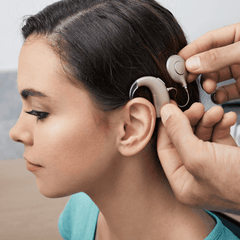Deaf Nurse Proves Doubters Wrong

"My audiologist told me a career in medicine wouldn’t be possible with hearing loss. There was a lot of frustration with people telling me I couldn’t do things because I couldn’t access sound."
Growing up, music was Nicole Fleming’s life. She played four different instruments, took voice lessons, and performed in musical theater. For college she planned to major in music – thinking medicine might be a back-up option. During her freshman year, that plan changed.
Fleming was in a science lecture but couldn’t hear the professor. She asked a classmate why the microphone wasn’t turned on. The classmate was confused – the microphone was on.
Fleming, coincidentally, was taking an American Sign Language (ASL) class that semester. She asked the teacher, who was hard of hearing, how he knew what “less hearing” looked like. The description sounded just like what Fleming experienced. She visited an audiologist and was fitted for hearing aids.
“Then it just kept going,” Fleming said. “Things kept getting quieter and quieter, so the hearing aids got bigger and bigger."
Fleming isn’t sure why she went deaf. She had an illness around the same time that could've contributed to the process. She also recently discovered a genetic history of a condition associated with hearing loss.
“It was a grieving process to have your entire life flipped upside down,” Fleming said. “And then my audiologist told me a career in medicine wouldn’t be possible with hearing loss either. There was a lot of frustration with people telling me I couldn’t do things because I couldn’t access sound and there wasn’t a way for me to be safe.”
Hearing implants help ensure a nursing career
Fleming’s hearing faded faster than she learned ASL, so there was a stretch where she felt lost with no ability to communicate. But she was determined not to be told what she couldn’t do.
She said goodbye to a musical career but refused to give up on medicine. She graduated with a BA in ASL and a BSN in registered nursing, and is currently pursuing her MSN part time while working full time at a hospital in Rochester, NY.
Fleming originally thought she wanted to be a doctor – in part because of the TV series Grey’s Anatomy – but gravitated toward nursing because of the prolonged patient interactions. She navigated nursing school by signing and using ASL interpreters and was content with the quiet. Then, her grandmother passed away.

“I was in the hospital when she was dying, but wasn’t able to hear what was going on,” Fleming said. “That's when I realized I could stay in my Deaf bubble, or I could get cochlear implants and be able to navigate both worlds more efficiently.”
Contrary to hearing aids that amplify sounds, cochlear implants (shown in photo) are small, implanted devices designed to stimulate the auditory nerve, helping Deaf or hard-of-hearing people hear in a new way. The implants digitize sound and aren't guaranteed to work. But for Fleming, who got them in 2021, they did.
Stethoscope technology helps with patient connections
Rochester has one of the largest Deaf populations per capita in the United States, and some of Fleming’s most meaningful encounters in the ER where she works have been with Deaf patients. She understands the importance of having a nurse or doctor who can communicate using ASL rather than an interpreter.
Fleming continues to sign and use interpreters on a daily basis. And combined with her 3M™ Littmann® CORE Digital Stethoscope and Eko CORE™ Digital Attachment, she can do what she was told she couldn’t: work in medicine.
"My stethoscope gives me a superpower. Instead of being 'the Deaf nurse' and being behind, it puts me ahead."
Fleming uses the CORE™ Attachment to connect her stethoscope via Bluetooth either to her cochlear implant or her cell phone. She's then able to hear sounds or see audio waveforms on her phone. The stethoscope’s noise cancelling capabilities help her hear key noises while in an ambulance or if a nearby child is screaming. Its Bluetooth capability means she can still examine a patient without being the one holding the stethoscope.
“Especially in pediatrics, it’s fantastic. I can hand the stethoscope over to a parent and they can put it on their child, and I can stand across the room because toddlers can be scared in those situations.”
Fleming hopes to continue working in Rochester and helping the Deaf community with support from her Eko stethoscope.
“I can be whichever version of Deaf I want to be, and my stethoscope will keep up,” Fleming said. “There are a lot of Deaf and hard-of-hearing people in medicine now, and our numbers are growing. It’s reassuring to see that there’s a company like Eko that has our backs – that’s going to empower us to be able to do all the really cool things we want to do.
“I’m one of the first Deaf nurses to work in emergency medicine, but I’m certainly not the last.”
Learn how Eko stethoscope technology can transform your stethoscope into a smart detection tool.
MKT-0002973
